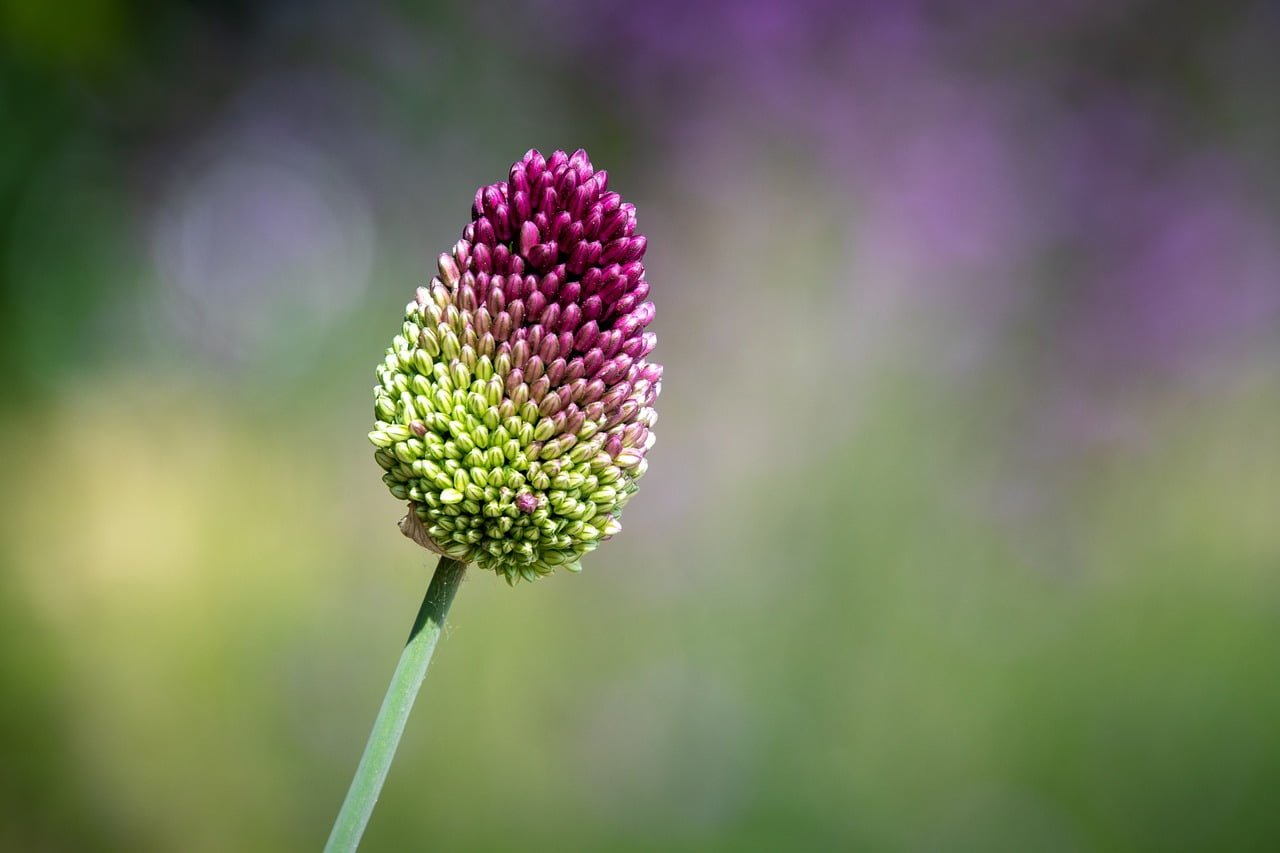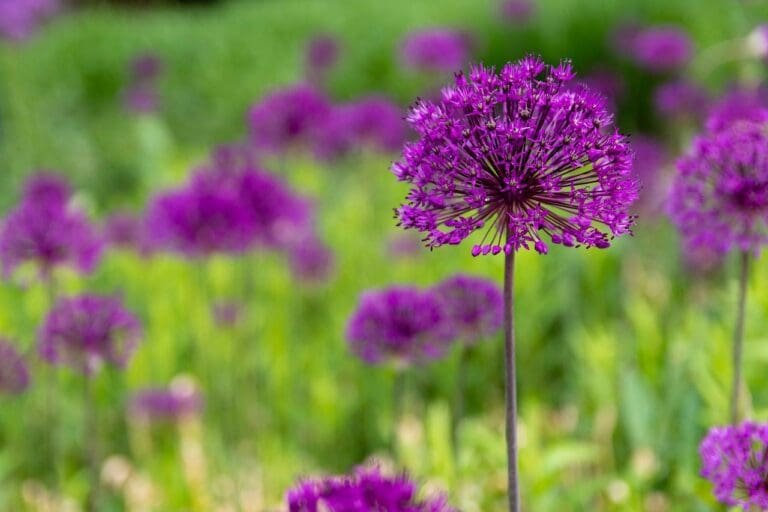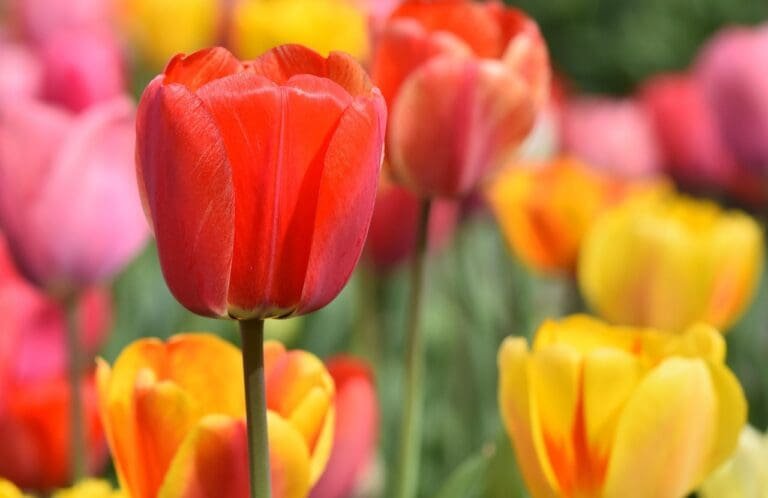With its unique drumstick-shaped flowers, Allium sphaerocephalon makes a striking addition to any garden. Learning how to grow Allium sphaerocephalon allows you to elevate your outdoor space with this ornamental beauty. Allium sphaerocephalon blooms in early summer, with each bulb producing a flowerhead made up of dozens of small, deep purple florets. When in full bloom, the densely packed florets create nearly spherical flowerheads that resemble reddish-purple pom poms. This guide will explore everything you need to know about how to grow Allium sphaerocephalon successfully.
You might also be interested in: Summer Flowering Bulbs for Wild Gardens
The Beauty of Allium sphaerocephalon
Allium sphaerocephalon brings welcome colour and height to flowerbeds and mixed borders. The strap-like green foliage provides a nice contrast to the oval flowerheads. Mature plants reach 60-90 cm (2-3 ft) in height. The flower stalks stand tall on their own but may need staking in exposed sites.
This allium makes an excellent cut flower. The unusual blooms last up to two weeks in floral arrangements. The drumstick allium also works well in rock gardens, cottage gardens, and open woodland settings. Plants spread slowly by offset bulbs, making solid clumps over time.
When and Where to Plant Allium sphaerocephalon
Allium sphaerocephalon grows best in full sun and well-drained soil. Like most bulbs, these alliums perform best in organically rich soils with a neutral pH. Work compost or aged manure into the planting area to improve drainage and provide nutrients.
Plant the bulbs in the fall, at least two months before the ground freezes. Fall planting allows the roots to become established before top growth appears in spring. Choose a site that won’t become waterlogged in winter.
Space the bulbs 10-15 cm (4-6 inches) apart and about 8 cm (3 inches) deep. Plant them at this shallow depth to ensure good drainage below the bulbs.
Caring for Allium sphaerocephalon Plants
Caring for Allium sphaerocephalon consists mainly of watering, fertilizing at the right time, lifting and dividing when the clumps get overcrowded, and providing winter protection in cold climates.
Watering
Give plants a thorough soaking after planting to settle the soil around the bulbs. Continue watering regularly if rainfall is lacking, especially when the flower stalks start elongating. Prolonged dry spells can cause poor flowering and stunt plant growth.
Fertilizing
Apply a balanced organic fertilizer or an all-purpose 10-10-10 granular fertilizer at planting time. This gives the bulbs an immediate source of nutrients for root growth.
Top dress plants with compost or bulb fertilizer when they emerge in spring. Supplemental feeding encourages strong stems and large, healthy blooms.
Lifting and Dividing
As the bulbs multiply over time, thick mats develop and flower size diminishes. Dig up overcrowded clumps after the foliage dies back and gently break apart the bulbs. Replant the offsets at their original depth, allowing plenty of room between plants for good air circulation.
Winter Care
In regions with extremely cold winter temperatures, provide winter protection by applying a 8-10 cm (3-4 inch) thick layer of pine needles, straw, or other organic mulch over the dormant plants. Remove the mulch after the last spring frost date.
The drumstick allium dies back completely after blooming and remains dormant for the rest of the summer. Allow the foliage to yellow entirely before removing it.
Troubleshooting: Pests, Diseases, and Other Problems
Allium sphaerocephalon is relatively trouble-free with few insect pests or diseases. Good cultural care mostly prevents problems, but challenges can arise on occasion. This section covers some common issues and remedies.
Onion Maggot
Onion maggot fly larvae tunnel into allium bulbs and stems, causing rot and plant death. To prevent infestations, practice crop rotation and remove old foliage promptly after it dies back. Protect bulbs with floating row covers after planting. As a last resort, apply beneficial nematodes or treat bulbs with neem oil before storage or planting.
Fusarium and Basal Rot
Several fungal diseases cause bulbs and roots to rot. Avoid planting in poorly drained sites. Discard any soft or diseased bulbs found at planting time. Follow proper planting depth and spacing guidelines to allow air circulation. Rotate planting locations and divide congested clumps regularly.
Leaf Spot and Botrytis
Leaf spot and head rot fungal diseases often occur in wet seasons. Improve air flow through proper spacing. Remove affected foliage promptly and destroy it (don’t compost it). Avoid overhead watering and allow plants to dry between irrigations. Apply fungicides only when absolutely necessary, following label directions carefully.
Yellowing Foliage
Premature yellowing of the strappy leaves usually indicates inconsistent watering. Rule out disease problems first, then modify watering routines to provide consistent moisture through the growing season. Ensure plants receive one inch of water weekly, including rainwater. Extreme summer heat can also cause early foliage dieback after blooming.
Poor Flowering
When plants fail to bloom well, improper planting depth or nutrition issues are often the cause. Other possibilities include overcrowding, excessive shade, or damage to the root system. For the best blooms, situate drumstick alliums in organically rich soil in full sun. Follow the planting, spacing, watering, and fertilizing recommendations provided.
FAQs – How to Grow Allium Sphaerocephalon
Q: How tall does Allium sphaerocephalon grow?
Allium sphaerocephalon reaches heights between 60-90 cm (2-3 feet) when in bloom. Allow plenty of vertical space when siting plants among other perennials and border plants.
Q: Is Allium sphaerocephalon edible?
No, Allium sphaerocephalon bulbs and flowers are considered ornamental alliums, not for culinary use. Other alliums like garlic, onions, leeks, and chives make tasty additions to meals. With its small bulb size and unknown flavour profile, the drumstick allium lacks appeal as an edible.
Q: Can I grow Allium sphaerocephalon in containers?
The vertically oriented foliage and flowers of the drumstick allium make it an eye-catching thriller in container combinations. Use a quality potting mix and choose a container at least 30-45 cm (12-18 inches) deep with drainage holes. Site containers in full sun. Provide routine fertilization and ample water during the growing season, allowing pots to dry slightly between waterings. Bring containers to a protected area in winter.
Q: When should I expect Allium sphaerocephalon to bloom?
In most regions, the intriguing pom pom blooms of Allium sphaerocephalon emerge in early summer. Flowering typically occurs May through June, lasting up to four weeks. Flower timing depends partly on planting depth and soil temperature at planting time. Blooms appear about two months after the strappy foliage emerges in spring.
Q: How can I prolong the life of Allium sphaerocephalon flowers?
Enjoy these late spring blooms while they last! Deadheading or cutting blooms for bouquets can prolong flower life slightly. Site plants away from harsh winds, staking taller stems if necessary. Avoid overhead watering during flowering time to discourage foliar diseases. Fertilize bulbs at planting and in early spring to help nurture the most robust blooms possible.
Final thoughts
Adding Allium sphaerocephalon bulbs to flowerbeds, borders, or containers brings intriguing late spring charm to outdoor spaces. Though relatively short-lived, their unique blooms make a memorable statement. Follow proper planting and care guidelines, and you’ll enjoy their striking drumstick flowers for years to come.



